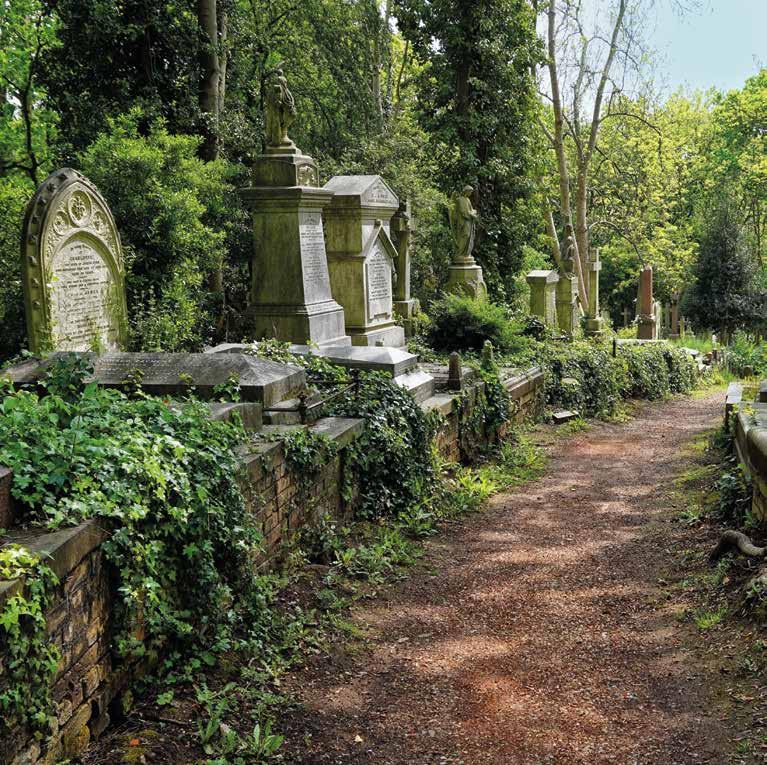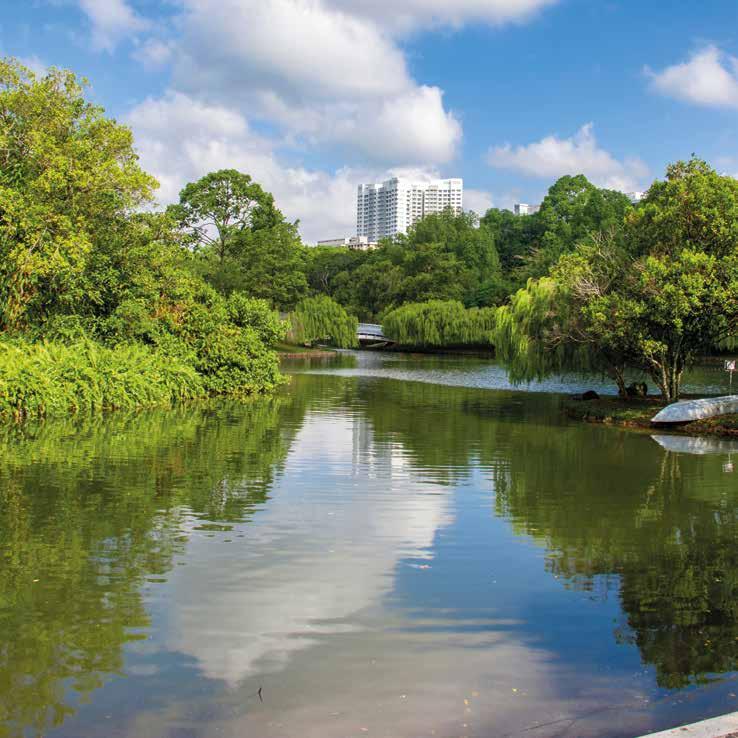
7 minute read
4. Identifying opportunities for urban rewilding
from Rewilding our cities
by ZSL
The Covid-19 pandemic has brought about a seismic shift in the way we think about space in cities. It became obvious during successive lockdowns that a lot of our urban environment is not green or accessible enough, directly impacting our health and wellbeing, particularly in more deprived areas of our cities. Sections 2 and 3 of this report have explored the potential benefits and challenges associated with the rewilding of our cities, but, practically speaking, where could we, or should we, retrofit our existing towns and cities to accommodate rewilded spaces? In this section, we explore opportunities for urban rewilding that could be considered practical, sustainable and likely contributing to the conservation and enhancement of nature and biodiversity.
4.1 Improving the proportion of vegetated private spaces
Advertisement
Often overlooked in comparison to parks and larger green spaces, private spaces such as domestic gardens are key components of urban ecology, providing multiple ecosystem services and refuge for urban wildlife. For example, the Greater London Area in the United Kingdom covers an area of 1,569 km2, with private gardens making up approximately 24% of this area. Only 57% of existing private gardens is vegetated cover however, meaning that approximately merely 14% of Greater London is made up of private green space. This percentage is declining, negatively impacting biodiversity (Webb and Moxon 2021). Similarly, the major faiths are important landowners and public facing bodies in many countries around the world. Cemeteries, places of worship and associated gardens are quiet spaces for reflection, but also important urban green spaces that could be partially or wholly rewilded (Figure 7). Being relatively undisturbed, they could represent significant opportunities for wildlife recovery, while still accommodating the needs of their users. Promoting a change in behaviour of private landowners, to convert part or all of their green spaces to attract more wildlife could increase cities’ biodiversity and resilience to climate change, while also improving health and wellbeing.
4.2 Public gardens and parks, partly or wholly
Public gardens and parks represent major green spaces in many cities and the partial rewilding of some or all of these areas could significantly boost urban wildlife recovery. In a number of situations, local authorities already have initiatives to actively increase nature within their areas, with, for example, one in five county councils having embraced rewilding on public land in Great Britain, with a growing number setting aside former golf courses, post-industrial scrubland and recovering waterways for nature (The Guardian 2022). Many local authorities may thus be interested in supporting a rewilding agenda for their city, potentially being willing to act as centres of rewilding effort, demonstration and wildlife recovery. The rewilding of public gardens and parks, taking into account current primary uses, could include passive approaches such as the removal of any form of management on parts of the land; but it could also include active replanting and targeted species recovery efforts, including potential translocations of wildlife into gardens and parks that are sufficiently large and well connected to sustain their populations.
Figure 7: Green spaces can spontaneously rewild during periods of neglect. This creates new opportunities for wildlife, but often requires careful balancing of the needs of nature with economic, social and cultural functions of such spaces. Highgate Cemetery, one of the ‘Magnificent Seven’ cemeteries in London, is one such site. During a period of neglect and economic problems in the 20th century, vegetation was able to grow unchecked, creating its characteristic overgrown appearance. In the eastern part, a secondary woodland formed. Today, the cemetery is a Site of Metropolitan Importance for Nature Conservation, and while management of the vegetation is more proactive to preserve the gravestones and historical monuments, biodiversity conservation remains an explicit aim of the management of the entire site (Highgate Cemetery 2019). Picture source: East cemetery of Highgate Cemetery © GaryPerkin, Shutterstock.
4.3 Railways
Cities’ railway networks often comprise extensive green space, including railway verges, unused tracks and other lineside landholdings, which, if rewilded, could help boost urban biodiversity in multiple ways. In the United Kingdom, for example, the primary rail infrastructure manager (Network Rail) is also one of the nation’s largest public landowners, with a total estate of 51,700 hectares, with the densest concentrations of this land in urban areas where rail lines converge. These landholdings represent and traverse diverse habitats (Figure 8), in theory providing refugia for rare and threatened species and enabling functional connectivity between habitat patches, as seen e.g., on French railways (Vandevelde and Penone 2017). Habitat availability and movement potential are critical for species persistence under pressure from human-induced threats, such as land use change and climate change (Morelli et al. 2017) and can be a particular challenge in complex urban environments. Yet green spaces surrounding railways are frequently subjected to intensive vegetation management and are sometimes disconnected from adjoining landscapes.
While some management is necessary for the safe and efficient operation of railways, there are significant opportunities to rewild the railway green spaces, particularly in cities, with benefits for urban biodiversity and people. In the UK, Network Rail recently made ambitious commitments to enhance biodiversity throughout its lineside estate and to maximise the value and connectivity of its landholdings as ecological corridors, including transforming its approach to vegetation management. Rewilding could represent a cost-effective way to deliver on this mission, from passive removal of management and amelioration of barriers to enable regeneration of habitats, enhance connectivity, and build ecological resilience, to active rewilding to restore processes like natural vegetation management and carbon sequestration.
Park Park/cemetery Train tracks

Informal green space
Figure 8: A train track running through East London, potentially connecting diverse green spaces. Used and unused train tracks, and adjacent vegetation, can create linear corridors through densely settled urban environments. These could connect urban green spaces (such as private gardens and public parks), as well as urban habitats with the surrounding rural landscape. Picture from Google Earth and Maxar technologies 2022.
4.4 Rivers, wetlands and estuaries
Many cities around the world have been built near and around rivers, wetlands and estuaries. Urban waterbodies can play a critical role in supporting urban biodiversity and ecosystem services in a rapidly changing world (see e.g., Belaire et al. 2022) with, for example, urban streams and vegetated riparian areas often providing vital connectivity across developed landscapes and often being important hotspots for both biodiversity and local provisioning of ecosystem services (Butler et al. 2022). However, in many places, sections of rivers are disconnected from their riparian zone or worse, buried in culverts (i.e., artificial structure to channel a subterranean waterway, such as a pipe or reinforced concrete), while wetlands are being drained or hidden under our feet, and intertidal habitats built on (Box 3). Rewilding provides an opportunity to reimagine how we manage urban surface water drainage and to daylight rivers and streams used as surface water sewers. The creation of wetlands will filter and improve water quality, replenish ground water and build resilience to extreme weather events and climate change. In many cities established on estuaries, there may be opportunities to create new intertidal habitats such as saltmarshes, mangroves or mudflats, which are important for supporting wildlife, including economically important fish species, as well as providing buffering from floods and storm surges. Rivers often forming natural blue corridors through urban centres. Deculverting rivers in cities and the removal of the numerous barriers that restrict fish movement could achieve a great deal for restoring ecosystem services and making space for wildlife, while allowing natural vegetation to cover the banks of urban rivers and streams could provide further resilience against extreme weather and contribute to increased functional connectivity.
Box 3: Rewilding an urban river
Historically, rivers in urban centres have been polluted by sewage and other by-products of people and their activities; their channels have been straightened to facilitate transportation (or diverted underground); they have been disconnected from their floodplains; and their water has been (over-) abstracted. Taken together, urban rivers are often severely degraded, having for example very little normal flooding behaviour, low water quality and reduced biodiversity (Everard and Moggridge 2012). Rewilding can be a useful tool to restore river functionality, with benefits for people and wildlife alike. One example for this is the Kallang River in Bishan-Ang Mo Kio Park in Singapore, whose channel had been straightened and reinforced with concrete in the 1970s as part of a series of hard infrastructure projects aimed at alleviating water management problems across Singapore. In 2006, this river was restored as part of Singapore’s Active, Beautiful and Clean (ABC) Waters Programme, which focuses on re-naturalising waterways to aid flood management and create new communal spaces. The channel was un-straightened and widened, slowing down the waterflow and creating habitats for freshwater species. Hard and soft engineering techniques, including the use of riverbank vegetation, were used to stabilise the new riverbanks. The river was also reconnected to a floodplain (the surrounding park), allowing excess surface water during rainstorms to drain away from the residential areas, thus restoring a key function of the river. In addition, accessibility to the park for the surrounding residents was improved, so that people could benefit from the revitalised river (An et al. 2020).

Kallang River in Bishan-Ang Mo Kio Park . © D a n n y Y e , S h u tters toc k








